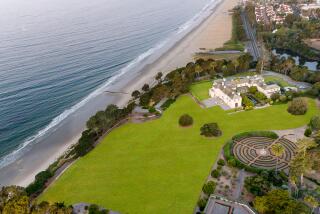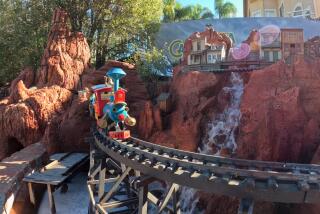Legion’s Castle Is Home to Tales of Hidden Riches, Bawdy Deeds
- Share via
PANORAMA CITY — Come with us to a castle shrouded in mystery, where local folk partake of a golden elixir and spin tales of hidden treasure, debauchery and last month’s all-you-can-eat spaghetti dinner.
This castle is not in a distant land, it’s on a side street in Panorama City behind a mini-mall. American Legion Post 817 has called it home since the early 1950s.
The two-story building is in the shape of a somewhat undistinguished castle, complete with turrets. Actually, the turrets are the only castle-like design element--the rest of the building was covered at some point with metal siding.
Inside is the main hall, where members sit on folding chairs for post meetings and watch a big-screen TV. From above, pictures of the 49 commanders who have led the post since it moved into the castle look down on the proceedings.
The other main room--less grand but almost always more populated--is the bar, which opens at 10 a.m. daily to serve up Budweiser on tap.
The bar, which is the post’s profit center, stayed open even after the room was almost destroyed by the Northridge earthquake. “We put together a makeshift bar,” recalled post member Joe Hutt, “for the workmen.”
Outside, in a paved area that may have been part of the castle’s legendary moat, the post will host a free hamburger and hot dog lunch for members Monday following a Memorial Day observance at a local cemetery.
Despite its convivial atmosphere, Post 817, like many veterans organizations, has had trouble attracting younger members in recent years. But if the most alluring legend surrounding the castle is true, it’s the young folks’ loss.
The old-timers who gather in the bar might be sitting, literally, on millions of dollars, hidden decades ago by a corrupt banker on the lam.
Or they could just be sitting atop a moneyless crawl space, kept free of mice by the post cat, Misty, who is--despite the name--a male.
“The cat wandered in about a year ago, and I guess whoever named him didn’t look too closely,” explained Hutt. “They took him over to the vet to get spayed. The vet said that wouldn’t be possible.”
But back to the treasure and the history of Panorama City’s only castle, built in 1925.
“I was told the castle took 11 months to build by two Englishmen who came here to America because they were facing jail under the old debtors law,” reads an account by Peter Spak, who was the post’s commander in 1952.
Around that time, Spak set down what he heard about the history from neighbors and former owners. His account, stored in the post’s archives, was published last year in the group’s newsletter. According to Spak’s report, the two guys on the lam purportedly built their home in the shape of a castle, including drawbridge and moat, to remind them of the land they fled. Or maybe they thought if British officials ever tracked them down, they could simply raise the drawbridge.
The Englishmen lived there for 10 years, and then the building “became a speak-easy and possibly a bordello,” reads Spak’s account.
“Customers would sit on the drawbridge with their drinks and fish in the moat.”
One should note here that none of these stories can be confirmed, and Spak doesn’t recall who his sources were. “My memory is shot,” said Spak, with a laugh, from his home in Carson City, Nev. “People started telling me stories, and I just wrote them down.”
Hutt, 73, gave a tour of the building, including the rectangular meeting hall that may have been a grand living room at one time. Narrow stairs on either side lead up to smaller rooms, now used for offices and storage.
Inside each of the round turrets is a small room that might have once been used as a bedroom.
“That’s where the girls were when it was a bordello,” said post member Chuck Cowles, 75, who wandered by during the tour.
How does he know that?
“After the earthquake, we went in there to fix the damage and some of the old walls were exposed. They had wallpaper on them with flowers this big,” he said, his arms held wide.
Outside, there was no sign there had ever been a moat. If it did exist, it was filled in long before the post moved in. Likewise, there was no longer a drawbridge.
After the speak-easy, according to the Spak papers, the castle was bought by the unscrupulous president of a savings and loan. He was sent to prison, but before he went, “it was said he absconded with $4 million to $14 million,” Spak wrote, adding, “It was rumored he buried the loot on the castle property.”
Thus the legend of the hidden treasure. The tale was passed on to the next owners, a Baptist church group, which organized a search, even going so far as to hire USC engineering students to examine the building and grounds, Spak wrote. Mounds of dirt that can still be seen in the crawl space are supposedly from digs the students made.
When the American Legion took over the building in the early ‘50s, the search began anew. “In those days,” said post member Allan Bales, “we had no trouble finding volunteers to do work. Everyone thought they might come across the money.”
The post made many changes to the building. In addition to the siding, an extension of the bar was built for booth seating, and the windows of one of the upstairs rooms were sealed off.
Like the church group before it, the veterans never found the money. But the legend lives on. Before a recent meeting at the post, members speculated on where the millions might be.
Past commander Jim Congdon doesn’t think they will ever have to worry about spending it.
“I’ve been through every single inch of this place,” he said. “If it was here, someone would have already found it.”
More to Read
Sign up for The Wild
We’ll help you find the best places to hike, bike and run, as well as the perfect silent spots for meditation and yoga.
You may occasionally receive promotional content from the Los Angeles Times.







